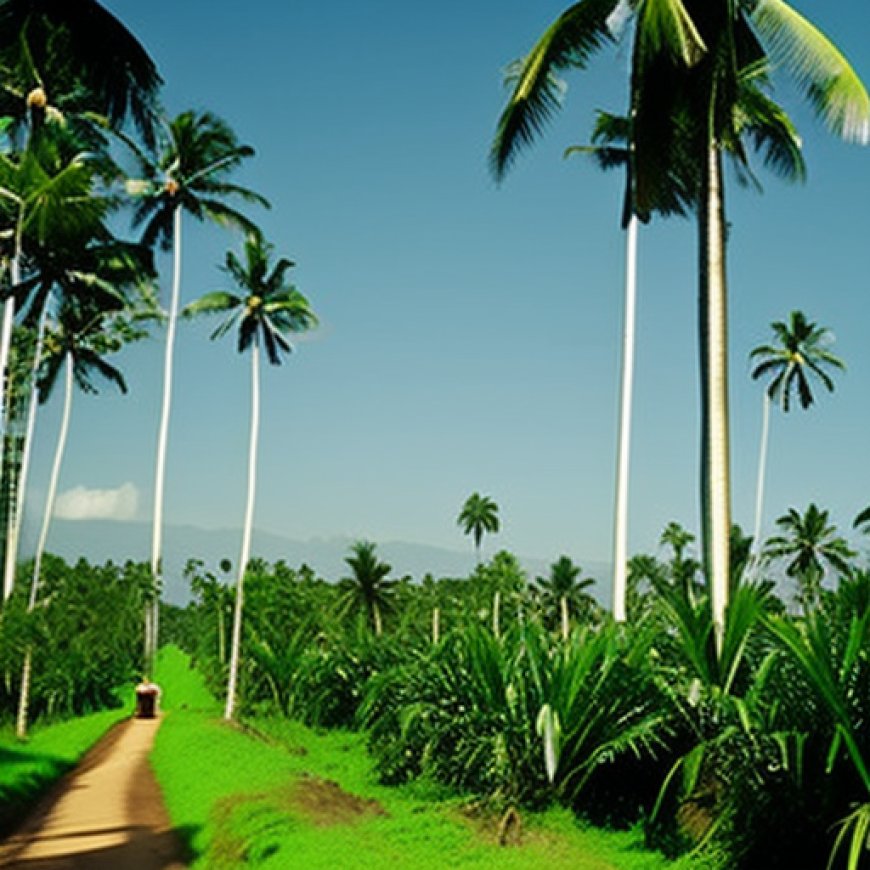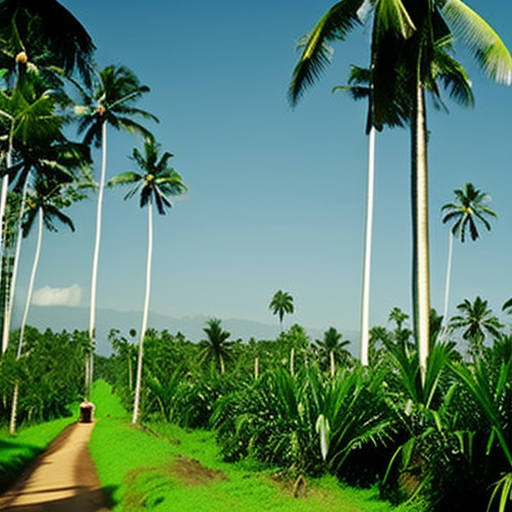200,000 hectares of Indonesian palm plantations to be forested, and other nature and climate stories you need to read this week
Discover this week's must-read nature and climate stories | World ... World Economic Forum


Sustainable Development Goals (SDGs)
1. 200,000 hectares of Indonesian palm plantations to be forested
- Around 200,000 hectares of palm plantations in areas designated as forests in Indonesia could be converted back to tree canopy, a government official has announced.
- Ownership of the plantation lands, which cover an area roughly two-and-a-half times as big as New York City, is expected to be returned to the state.
- The move follows legislation issued in 2020 aimed at clarifying the legal status of plantations operating in areas designated as forests.
- Around 3.3 million of the country’s 17 million hectares of palm plantation have so far been identified as illegally occupying land that should be tree canopy.
- Plantation owners falling foul of the rules will face a fine and no longer be able to grow palm oil on the land.
- Indonesia is the world’s biggest producer of palm oil, which is used in products including cakes and biscuits, cosmetics, soaps and cleaning products.
- As part of government efforts to mitigate climate change, an estimated 200,000 hectares of palm plantations found in forest areas will be returned, Bambang told reporters, but this total may increase.
2. Earth’s carbon budget for 1.5°C will be exhausted by 2029, says IPCC
- Humanity is burning through its available carbon budget quicker than originally thought, scientists say.
- Without urgent and concerted global efforts to reduce atmospheric CO2 emissions that cause climate change, we could breach the 1.5°C limit by 2029 instead of the mid-2030s, The Guardian reports.
- Globally, 2023 saw extreme heat and unprecedented temperatures, including the world’s hottest-ever month recorded in July. Mean-average annual temperatures for the year are expected to be close to 1.5°C above pre-industrial levels.
- While this could be a one-off extreme year, scientists are concerned that soon the volume of CO2 in the atmosphere will keep temperatures at dangerous levels for longer.
- UN advisory body the Intergovernmental Panel on Climate Change had forecast that the world could afford to emit another 500 billion tonnes of CO2 and have a 50% chance of keeping below the 1.5°C target. This budget assumed annual carbon dioxide emissions of around 40 tonnes.
- However, new research into the impact of a global ban on aerosols has led scientists to recalculate the remaining carbon budget.
- The latest estimate leaves 250 billion tonnes, which brings forward the 1.5°C deadline to 2029 – just six years from now, The Guardian says.
3. News in brief: Other top nature and climate stories this week
- The US Environmental Protection Agency must phase out food waste from landfill sites by 2040, government officials from 18 states have said. The group has called for concerted action to reduce the impact of methane emissions that fuel the climate crisis.
- Residents in three areas of Northern Queensland in Australia have been ordered to evacuate their homes as out-of-control bushfires threaten their communities. The blazes have already killed two people and destroyed many homes.
- The funding gap for climate adaptation is 50% higher than previously estimated, the UN Environment Program says. It is estimated that poorer countries require between $194 billion to $366 billion to adapt to climate change, with existing finance flows standing at just $25 billion for the 2017-2021 period.
- Global warming has caused Nepal’s snow-topped mountains to lose almost one-third of their ice in the last 30 years, says UN Secretary-General Antonio Guterres during a visit to Mount Everest.
- 1.6 million acres of US Great Plains grassland has been destroyed in one year, data from the World Wildlife Fund shows. This equates to an area the size of Delaware state being ploughed for agricultural use.
- Chad in Africa has reported its first dengue fever outbreak, according to the World Health Organization. More than 1,300 suspected cases have been identified and one death reported to date.
- Musicians Filkins Drift walked 870 miles around Wales in the UK, carrying their instruments to bring music to remote communities. The mammoth hike aims to encourage the music industry to change its mindset on sustainable touring.
- The Baltic Sea faces “critical challenges” as a result of the climate crisis and biodiversity degradation, with little or no improvement in its health between 2016 and 2021, according to a report by scientists at the Baltic Marine Environment Protection Commission.
- Mexico has announced a $3.4 billion plan to rebuild the coastal resort of Acapulco, which was devastated by Hurricane Otis. The recovery plan includes tax breaks, humanitarian relief and infrastructure reconstruction costs.
4. More on the nature and climate crisis on Agenda
- The ingenuity of young leaders is a key component of efforts to protect the Amazon rainforest and improve the lives of its communities. These people must be listened to. Here’s why.
- The European Commission has proposed a methane emissions limit on EU gas imports. If adopted, the proposal could put pressure on the bloc’s fossil fuel suppliers to prevent methane leaks in their oil and gas infrastructure.
- A sustainable future rests on humanity resolving the most complex, systemic and existential risks facing the planet. Here are five drivers to achieve system-level change.
Our Impact
- Scaling up green technologies: Through a partnership with the US Special Presidential Envoy for Climate, John Kerry, and over 65 global businesses, the First Movers Coalition has committed $12 billion in purchase commitments for green technologies to decarbonize the cement and concrete industry.
- 1 trillion trees: Over 90 global companies have committed to conserve, restore and grow more than 8 billion trees in 65 countries through the 1t.org initiative – which aims to achieve 1 trillion trees by 2030.
- Sustainable food production: Our Food Action Alliance is engaging 40 partners who are working on 29 flagship initiatives to provide healthy, nutritious, and safe foods in ways that safeguard our planet. In Vietnam, it supported the upskilling of 2.2 million farmers and aims to provide 20 million farmers with the skills to learn and adapt to new agricultural standards.
-
SDGs, Targets, and Indicators Identified in the Article
SDGs Targets Indicators SDG 15: Life on Land Target 15.2: By 2020, promote the implementation of sustainable management of all types of forests, halt deforestation, restore degraded forests, and substantially increase afforestation and reforestation globally Indicator 15.2.1: Progress towards sustainable forest management SDG 13: Climate Action Target 13.2: Integrate climate change measures into national policies, strategies, and planning Indicator 13.2.1: Number of countries that have integrated mitigation, adaptation, impact reduction, and early warning into primary, secondary, and tertiary curricula Indicator 13.2.2: Number of countries that have communicated the strengthening of institutional, systemic, and individual capacity-building to implement adaptation, mitigation, and technology transfer SDG 12: Responsible Consumption and Production Target 12.3: By 2030, halve per capita global food waste at the retail and consumer levels and reduce food losses along production and supply chains, including post-harvest losses Indicator 12.3.1: Global food loss index Indicator 12.3.2: Food loss index for production and supply chains 1. Which SDGs are addressed or connected to the issues highlighted in the article?
- SDG 15: Life on Land
- SDG 13: Climate Action
- SDG 12: Responsible Consumption and Production
2. What specific targets under those SDGs can be identified based on the article’s content?
- Target 15.2: By 2020, promote the implementation of sustainable management of all types of forests, halt deforestation, restore degraded forests, and substantially increase afforestation and reforestation globally (SDG 15)
- Target 13.2: Integrate climate change measures into national policies, strategies, and planning (SDG 13)
- Target 12.3: By 2030, halve per capita global food waste at the retail and consumer levels and reduce food losses along production and supply chains, including post-harvest losses (SDG 12)
3. Are there any indicators mentioned or implied in the article that can be used to measure progress towards the identified targets?
- Indicator 15.2.1: Progress towards sustainable forest management (SDG 15)
- Indicator 13.2.1: Number of countries that have integrated mitigation, adaptation, impact reduction, and early warning into primary, secondary, and tertiary curricula (SDG 13)
- Indicator 13.2.2: Number of countries that have communicated the strengthening of institutional, systemic, and individual capacity-building to implement adaptation, mitigation, and technology transfer (SDG 13)
- Indicator 12.3.1: Global food loss index (SDG 12)
- Indicator 12.3.2: Food loss index for production and supply chains (SDG 12)
4. Table: SDGs, Targets, and Indicators
SDGs Targets Indicators SDG 15: Life on Land Target 15.2: By 2020, promote the implementation of sustainable management of all types of forests, halt deforestation, restore degraded forests, and substantially increase afforestation and reforestation globally Indicator 15.2.1: Progress towards sustainable forest management SDG 13: Climate Action Target 13.2: Integrate climate change measures into national policies, strategies, and planning Indicator 13.2.1: Number of countries that have integrated mitigation, adaptation, impact reduction, and early warning into primary, secondary, and tertiary curricula Indicator 13.2.2: Number of countries that have communicated the strengthening of institutional, systemic, and individual capacity-building to implement adaptation, mitigation, and technology transfer SDG 12: Responsible Consumption and Production Target 12.3: By 2030, halve per capita global food waste at the retail and consumer levels and reduce food losses along production and supply chains, including post-harvest losses Indicator 12.3.1: Global food loss index Indicator 12.3.2: Food loss index for production and supply chains Behold! This splendid article springs forth from the wellspring of knowledge, shaped by a wondrous proprietary AI technology that delved into a vast ocean of data, illuminating the path towards the Sustainable Development Goals. Remember that all rights are reserved by SDG Investors LLC, empowering us to champion progress together.
Source: weforum.org

Join us, as fellow seekers of change, on a transformative journey at https://sdgtalks.ai/welcome, where you can become a member and actively contribute to shaping a brighter future.







